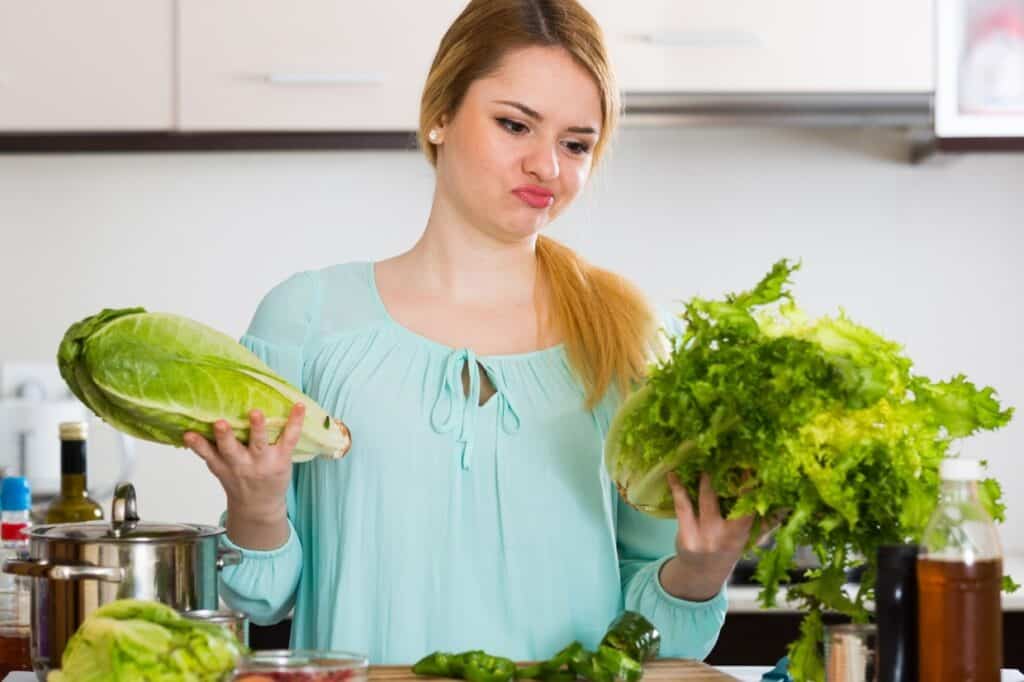How do you store fresh-picked tomatoes? What about those heads of lettuce you just got on sale?

Deep in gardening season, finding or growing fresh vegetables is easy. Still, improper storage can quickly turn bounty into waste. Learn about the most common vegetable storage mistakes and how to avoid them to save money and extend your vegetables’ shelf life.
The importance of proper vegetable storage
With rising food prices, bulk-buying seasonal produce or planting a vegetable garden can help cut costs. And while meal planning based on seasonal eating can also help, knowing how to store vegetables for later use can save even more money all year and reduce waste.
Common storage mistakes and how to fix them
Storing seasonal produce correctly can avoid food spoilage and the unnecessary costs of buying expensive out-of-season vegetables in winter. Luckily, the most common vegetable storage mistakes also have easy fixes.
Refrigerator overcrowding
One of the most common mistakes is overcrowding the refrigerator. Overloading your fridge reduces air circulation, causing vegetables to spoil faster.
To prevent this, organize your fridge to allow airflow around your produce. Use separate shelves for different types of vegetables, and avoid stacking them too tightly.
Incorrect temperature settings
Vegetables require specific temperature ranges. Setting your refrigerator too cold or too warm can damage your produce.
Most vegetables store best at temperatures between 32 F and 40 F. Keep a thermometer in your fridge to monitor the temperature and adjust as needed.
Storing ethylene-producing and ethylene-sensitive vegetables together
Certain vegetables produce ethylene gas, which can cause others to ripen and spoil prematurely. Tomatoes and apples, for instance, produce ethylene, while leafy greens and cucumbers are sensitive.
Store ethylene-producing vegetables separately from those sensitive to it. This will help to extend their shelf life.
Using plastic bags incorrectly
Plastic bags can trap moisture, leading vegetables to mold and rot. Instead, use perforated plastic bags or cloth bags.
This allows good airflow while retaining moisture. To keep leafy greens crisp and fresh, wrap them in a damp paper towel before placing them in a perforated bag.
Neglecting root vegetables
Root vegetables like carrots and potatoes need special care, especially if you can’t store them in a root cellar. Alternatively, store carrots in a container with water in the fridge to keep them crisp.
Keep your potatoes in a cool, dark place, such as a pantry or cellar, to prevent sprouting and spoilage. Avoid storing potatoes in the fridge, as cold temperatures convert their starch into sugar, affecting their taste and texture.
Vegetable-specific storage tips for August
As the summer gardening season ends, fresh, ripe vegetables are easy to find on sale at supermarkets and farmstands, or even in your backyard garden. It’s tempting to save money by bulk buying seasonal produce.
According to a USDA report, food prices increased by 25% from 2019 to 2023. However, your kitchen may soon hold more tomatoes or zucchini than your family can eat.
Don’t let your great August vegetable deals spoil because of improper storage. Use these tips to make them last longer.
Tomatoes
Don’t refrigerate unripe tomatoes, as cold temperatures can make them mealy. Instead, store them at room temperature, out of direct sunlight, or in a paper bag.
Once fully ripe, refrigerate tomatoes to prolong their shelf life. For the best flavor, however, let them come to room temperature before using them.
Cucumbers
Cucumbers can become mushy if stored too cold. Keep them in the refrigerator’s crisper drawer at around 50 F. If your fridge is too cold, store your cucumbers on the countertop for a few days, but use them quickly.
Bell peppers
Store bell peppers in a plastic bag in the refrigerator’s crisper drawer to keep them crisp. Whole peppers last longer than cut ones, so only slice them when ready to use.
Zucchini and summer squash
Zucchini and summer squash can soften quickly if not stored properly. For the best quality, keep them in a perforated plastic bag in the fridge’s crisper drawer, and try to use them within a week.
Corn on the cob
Corn should be stored in the refrigerator with the husk on. For the best flavor, use it within two days of purchase or harvest. If you need to store it longer, blanch and freeze the kernels.
Expert tips and recommendations
Consider a little prep work for long-term storage. “Blanching and freezing my summer produce to use later has been one of the most useful skills I’ve learned over the years,” says food blogger Brooke Burks of The Buttered Home. “Enjoy the benefits of hard work now, later.”
Another way to keep seasonal produce fresh longer is vacuum sealing. Vacuum sealing removes air and prevents freezer burn, helping extend the shelf life of vegetables.
Hydrocooling cools leafy greens quickly in ice water. This method of storing lettuce helps extend its freshness.
Remember, traditional methods of storing fresh summer vegetables, such as using a root cellar, can be very effective for keeping root vegetables and other produce.
Proper vegetable storage to save money
Proper vegetable storage helps maximize shelf life and reduce waste, especially with current food price trends. By avoiding common mistakes and using the tips provided, you’ll keep your summer produce fresh longer, save money and enjoy the season’s bounty.
Sarita Harbour is a long-time business and personal finance writer and blogger at An Off Grid Life. Find money-saving recipes at her new site, Recipes From Leftovers.